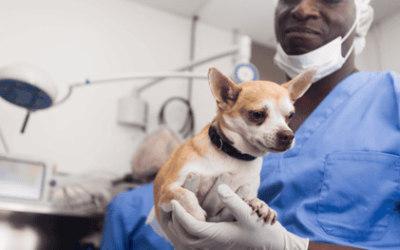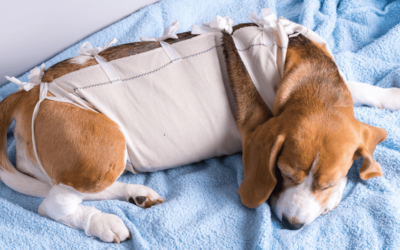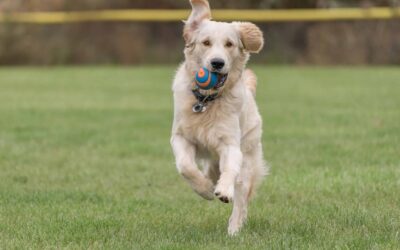Parvo In Dogs & Puppies [Symptoms, Causes & Treatments]

As a dog or puppy parent, part of your care for them is to stay aware of common viruses that could affect your pet. One such virus is the highly contagious canine parvovirus that affects dogs and puppies. This deadly virus attacks a dog’s gastrointestinal tract. Once a dog contracts the intestinal virus, it can kill within days. It’s easily transmitted to surfaces, people, and environments.
This article will help you learn about the causes, symptoms, and treatment options for parvovirus. Arm yourself with the knowledge to protect your canine friends.
Table of contents:
- Causes of Canine Parvovirus Infection
- Parvo in Humans: Myth vs. Reality
- Can Cats Contract Parvo from Dogs?
- Transmission and Risk Factors of Canine Parvovirus
- Process (Stages) of Canine Parvovirus Infection
- Infection
- Incubation
- Illness
- Symptoms and Complications of Canine Parvovirus
- Diagnostic Tests for Canine Parvovirus
- Treatment Options and Cost for Canine Parvovirus
- How Much Does Parvo Treatment Cost?
- Are There Home Remedies for Parvo?
- Prevention and Vaccination against Canine Parvovirus
- Can Pet Insurance Provide Coverage for Such an Investment?
- Illness & Injury Plan
- Accident Only Plan
- Wellness Plan
- Frequently Asked Questions (FAQs) about Canine Parvovirus
Causes of Canine Parvovirus Infection
Canine Parvovirus (CPV) first appeared in parts of Europe in 1976. Just two years later, this fast-spreading virus spread worldwide, causing an epidemic of inflammation in dogs’ heart muscles and intestines. CPV isn’t limited to dogs. It causes infections in wolves, coyotes, foxes, skunks, raccoons, and other wild animals. It’s closely linked to the feline panleukopenia virus, and scientists believe CPV results from two or three genetic mutations of FPV, which caused it to expand infections to dogs. Today, CPV isn’t as prevalent as in the 1970s due to the development of vaccines. Puppies should be kept away from other dogs and public areas until after they’ve received their parvo vaccinations.
Parvovirus is spread when a dog has contact with contaminated surfaces of water or food bowls, leashes, and clothes. It’s also spread through contact with urine or feces from an infected dog. Dogs contract the virus up their nose or into their mouths. Unvaccinated dogs are at risk of getting this virus.
An infected dog sheds the virus before their symptoms appear, usually four or five days after exposure. They will keep shedding the virus for ten days after they’ve recovered. If your puppy or dog gets parvovirus, they should be quarantined until they recover and stop shedding it.
Parvo in Humans: Myth vs. Reality
Canine parvovirus cannot infect humans, and human parvovirus can’t spread to your pets. Parvovirus B19, or the fifth disease, affects only humans. This illness affects mostly children or immunocompromised individuals. It’s spread through saliva, nasal discharge, coughing, and sneezing. Parvovirus B19 also spreads through blood. This virus causes a mild rash and symptoms similar to the common cold. It’s a myth that pets get this virus. Dogs and cats can be affected by other parvoviruses but cannot infect humans. Pets receive vaccinations to prevent them from their parvoviruses.
Remember: Humans cannot catch or infect their pets with this virus. Parvovirus B19 only affects humans. If you’re sick with this virus, your dog or cat won’t get the virus from you.
How to Avoid Spreading the Canine Parvovirus
The best defense against canine parvovirus is good hygiene and taking some preventative measures. Protect your puppy against the virus by getting them the proper vaccines. Puppies can receive a canine parvovirus vaccination at 14 to 16 weeks. Adult dogs should stay up to date on their parvo vaccinations, usually every three years, because this keeps their antibody levels high so they are protected from the virus. If your puppy isn’t old enough or has yet to receive their parvo vaccinations, keep them away from stores, puppy classes, doggy daycare facilities, groomers, or kennels.
Can Cats Contract Parvo from Dogs?
Canine Parvovirus is widely known to cause disease in dogs, but according to studies, mutated strains of CPV can infect cats under some circumstances. The strain CPV2b is thought to cause the disease in some domestic cats.
It’s uncommon for a cat to get parvovirus from a dog, but if a cat comes in contact with an infected dog, the animal should be quarantined from other cats and considered contagious for at least a couple of weeks.
CPV2b doesn’t cause major symptoms in cats. Cats with canine Parvo are asymptomatic, meaning they don’t show symptoms and aren’t in danger from this disease. Fortunately, the feline parvo vaccinations are effective against CPV2b.
Transmission and Risk Factors of Canine Parvovirus
This CPV is spread among dogs through contact with feces, urine, or contaminated items such as
- Leashes
- Food dishes
- Water bowls
- Clothing
- Toys
When a dog sniffs or ingests contaminated items, the virus enters its body through its nose or mouth. Dogs should be vaccinated to prevent infection because the virus has been in the environment for a long time.
Process (Stages) of Canine Parvovirus Infection
- Infection – When a dog or puppy is infected with CPV, there is an incubation period of three to six days with no symptoms.
- Incubation – During the incubation period, the CPV divides cells and spreads the virus throughout the dog’s body. The virus attacks the dog’s tonsils and lymph nodes in their throat. CPV invades the dog’s white blood cells, cloning itself to hide from the dog’s immune system. The dog’s immune system is shut down at this point, causing lymphopenia or a lack of healthy white blood cells.
- Illness – Once the virus enters the dog’s bloodstream, it targets the bone marrow and the walls of the dog’s intestines. The virus may affect the heart muscle in young dogs and cause arrhythmia. By now, the dog’s body can’t protect itself at all. The virus invades the gastrointestinal tract. This is where CPV does most of the damage. CPV destroys the lining tissue of the small intestines, which absorbs nutrients and prevents dehydration and bacterial infections in the dog’s gut, causing extreme nausea and diarrhea. Eventually, the dog’s intestines are so damaged they become dehydrated and in shock. If CPV doesn’t kill a dog, it leaves them severely ill. They’re at risk for septic shock from intestinal bacteria that spreads throughout their bloodstream.
Symptoms and Complications of Canine Parvovirus
Symptoms of CPV vary depending on the dog’s age and the severity of the illness. Young puppies with poor immune systems and no vaccinations are hit the hardest. Symptoms of CPV spread quickly after the incubation period of six to ten days. Symptoms of CPV include:
- Nausea
- Vomiting
- Bloody diarrhea
- Loss of appetite
- Depression
- High Fever
- Lethargy
Contact your vet immediately if your dog or puppy displays some of these symptoms. Early diagnosis is key to survival. Your vet will run tests to determine whether your dog is infected with the Canine Parvovirus.
CPV is a deadly disease. If the dog or puppy survives the virus, they may be left with complications such as
- Arrhythmia
- Weak heart
- Chronic gut problems
Diagnostic Tests for Canine Parvovirus
Your vet will diagnose your dog for CPV based on your dog’s symptoms, medical history, and fecal antigen test.
- Fecal test – The fecal antigen test is easy and quick. It’s the best way to check for CPV in your dog’s stool. The test is a rapid antigen test to detect any strains of CPV. If the test is done too soon after exposure or late into the infection, it may give a false negative, which is why your vet will perform other tests to confirm a diagnosis.
- PCR – The PCR are genetic tests that check the blood, tissues, and feces for CPV. This test is more accurate, with fewer false negatives than a fecal test.
- X-rays – To check for signs of other problems such as roundworms, hookworms, whipworms, or giardia.
- Blood work – Gives the vet baseline bloodwork numbers to work with.
Treatment Options and Cost for Canine Parvovirus
There is no medication or treatment to kill CPV in your dog’s system. Instead, your vet will create a treatment plan to manage symptoms and support the dog’s body to help the dog’s immune system fight off the virus naturally.
Because there is no cure for CPV, management of symptoms is important, as is continuous monitoring to ensure that the condition is not worsening. With proper treatment, a dog has a 90% chance of survival, depending on their age and health status before the infection.
Immediate care is important, usually involving intensive and round-the-clock care to combat.
- Dehydration
- Protein loss
- Fluid loss
- Replace electrolytes
- Anti-vomiting medications
- Anti-diarrhea medications
- Antibiotics to stop bacterial infections
Since CPV is so contagious, the dog or puppy must be isolated from other dogs to minimize the spread of the infection. Be sure to wash your dog’s bedding, bowls, and toys. Talk to your vet about the best type of disinfecting and cleaning agents.
How Much Does Parvo Treatment Cost?
A CPV test in your vet’s office can cost $40 to $100, depending on your veterinarian. Treatment costs are much higher, with an average of $500 to $2,000. You will pay more if your dog or puppy requires hospitalization for some time. Treatment costs can add up. These costs include
- Stomach xrays-$150 to $300
- Bloodwork- $80 to $200
- IV fluids-$50-$75
- Fecal exam-$45-$50
The best way to avoid your dog or puppy getting CPV is to keep them up-to-date on their CPV vaccinations.
Are There Home Remedies for Parvo?
There are no specific home remedies for Canine Parvovirus, but there are some things you can do at home to help alleviate some of the symptoms, such as diarrhea and vomiting, which can lead to dehydration. If you suspect your dog has CPV, although your best course of action is to take your dog to the vet immediately, some home remedies can help, such as
- Feeding your dog or puppy a bland diet of rice and chicken
- Probiotics
- Electrolyte supplements
Prevention and Vaccination against Canine Parvovirus
The CPV vaccination is usually included in a combination shot which includes
- Distemper
- Canine Adenovirus
- Parainfluenza
These are given every three to four weeks from the time your puppy is six weeks old until he’s sixteen weeks old. After this, the dog will get a boost vaccination once a year and every three years after that.
CPV is a hardy, quick-spreading virus that kills. Once a dog is infected, it isn’t easy to disinfect areas, bedding, clothing, bowls, and toys. Isolation is important to stop the spread of infection. CPV vaccinations protect your dog and puppy and help reduce the huge cost and amount of work associated with this infection and recovery.
How effective is the CPV vaccination?
CPV vaccinations are the best option to protect your pets, but like many medications, they aren’t one hundred percent effective. Studies show that 28% of vaccinated puppies and 11% of adult dogs still get Parvo. That being said, the study also found that dogs and puppies vaccinated had a better chance of surviving and recovering from the virus than those not vaccinated.
Can Pet Insurance Provide Coverage for Such an Investment?
It’s a huge concern when your pets get sick. If this happens, you want to give them the best care possible to help them get well, which could involve costly tests and treatments. Part of pet care involves preparing for unexpected illnesses or injuries. Pet healthcare insurance helps offset the costs of pet care.
Illness & Injury Plan – This plan is the most extensive. It offers choices of the type of coverage for want for your pet. This plan covers emergency vet visits, overnight hospital stays, surgeries, CAT and MRI scans, and more. It’s the comprehensive plan you so your pet gets the best care in light of an illness. This affordable plan is only $25 a month for cats.
Accident Only Plan – This plan provides coverage for emergency vet care due to accidents. It’s the perfect plan for first-time pet parents, tight budgets, or pets with pre-existing health conditions. The Accident Only Plan costs a mere twenty-five cents a day. It’s worth the peace of mind you can have to know your pet is covered in case of an accident.
Wellness Plan – Our wellness plan covers routine care for your dog or puppy. This plan offsets the cost of vaccinations, flea and tick meds, and fecal exams. You choose the basic plan or the plus plan depending on your pet’s needs.
FAQs
Can a Dog Live a Normal Life After Parvo?
Parvo fully resolves, and the dog does not have any lasting issues. However some cases, it is possible that there are complications and lasting damage to systems. This is why early detection and symptom management is critical.
Can Dogs Survive Parvo Without Treatment?
There is very good survivability from Parvo with proper care and symptom management.
How Many Days Can Parvo Last?
Once a dog is infected with the virus, it may take three to seven days for symptoms to appear. After the symptoms appear, a dog will usually be sick for five to ten more days.
Why Is Parvo Not Curable?
Viruses are hard to kill. They constantly mutate and can live long in the environment because infected dogs are shedding them, making the Canine Parvo vaccine considered one of the most important vaccines for dogs and puppies.
What to Feed a Puppy with Parvo?
It’s best to feed a puppy with Parvo a bland diet of chicken and rice. It is also very important to ensure that a puppy with Parvo is getting enough fluids, as dehydration is likely to occur with gastrointestinal symptoms. Encourage water drinking and supplement with electrolytes as advised by a veterinarian.
When Is It Too Late to Treat Parvo?
Most dog or puppy deaths due to Parvo occur within the symptoms’ first 48 to 72 hours. If you see symptoms of CPV, contact your vet immediately.
When Do Puppies Get Parvo Vaccine?
Puppies can get the parvo vaccine at six, eight, and twelve weeks. They must get these vaccinations so they’re completely immune to the virus. After this, a puppy receives a parvo booster shot at fourteen to sixteen weeks.
How Do Dogs Act When They Have Parvo?
The first symptoms of CPV in dogs are fever, lack of appetite, and lethargy. As the illness progresses, your dog will have diarrhea and vomiting.
How Long Does Parvo Last?
When a dog is infected with CPV, the symptoms won’t appear for several days. After symptoms show up, a dog will be sick for another five to ten days. Depending on the dog’s age and health, recovery may be another week after this.



